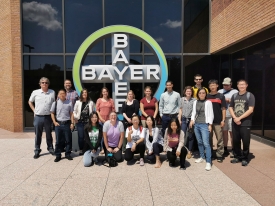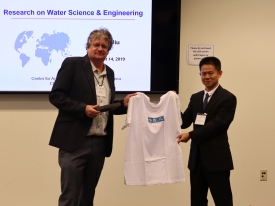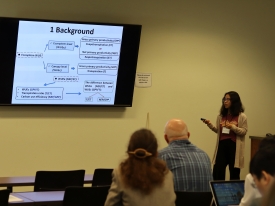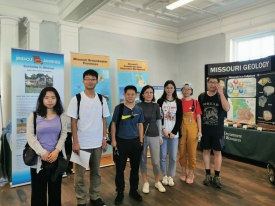







On August 10, 2019, under the support of the international training and improvement program for graduate students of China Agricultural University (CAU), led by Dr. Jun Niu, the department head of hydraulic engineering, and Dr. Fei Tian, an visiting team of 8 teachers and students went to University of Missouri (MU) to carry out an international exchange activity for 10 days.
The State of Missouri is located in the central belt of the United States. The Missouri river and the Mississippi River flow through the west and east of the state respectively. It is the main producing area of maize, wheat and soybeans, and is also the hometown of the famous American writer Mark Twain. More than 50,000 people work in the biological sciences in Missouri, leading the world in plant science and animal health. University of Missouri - Columbia is one of the 34 universities in Missouri, recognized as a world-class university group as the member of the Association of American Universities (AAU), is the only member of the American Association of University and the Carnegie endowment for higher education of "Horizontal research Universities", known as "public ivy league school" reputation of the state. Columbia branch school has 20 departments and colleges in all, and the academic achievements of agricultural college, engineering college, and communication college are famous all over the world especially.
On the afternoon of August 11, in Bradford Research Center, professor Christopher Daubert, vice President of University of Missouri, and professor Bob Sharp, director of Interdisciplinary Plant Group of agriculture, food and natural resources colloge, expressed warm welcome to teachers and students from water conservancy and civil engineering college of China Agricultural University, wished a smooth accomplishment of this international communication project, and looked forward to establishing further cooperation partnership.
In this international exchange activity, the visiting team visited many representative experimental research centers and field research bases. Among them, on August 11, teachers and students of the two universities visited the Bradford research center, which is located about 11 miles east of the University of Missouri and covers an area of about 591 acres. It is the largest experimental base for crops, soil and agriculture-related research in Missouri. During the visit, the teachers and students of the University of Missouri introduced the content, purpose, and progress of the research at the experimental site to us.
On August 12, the visiting team also headed to the MOFLUX site in the ozark region of central Missouri. The site is located in the transition zone between the hardwood and prairie areas of the central United States and has important ecological significance. Students learned about the historical development of the eddy covariance flux site, visited its main research equipments, and learned about the leaf gas exchange and polyacrylamide fluorescence measurement experiments, tree ring coring and quantitative wood anatomy methods, and species identification in vegetation plots. In addition, at the Baskert Wildlife Research and Education Center, students observed and exchanged views on the long-term vegetation project, agricultural legacy project, clearcut project, fire ecology project, maple syrup bush and maple syrup preparation process and methods.
Moreover, on August 15, the visiting team visited Bayer and the Donald Danforth Plant Science Center in st. Louis. Bayer is a multinational enterprise, whose core competitiveness in the life science field includes agriculture and medical care. Company products and services are committed to the benefit of people and improvement of life quality. In the background of the major global challenges including climate change, limited natural resources and a growing population, the company is dedicated to achieving sustainable future agriculture through innovation, digital transformation and collaboration. During the visit, the staff of the company showed us many sophisticated scientific research methods, such as gene gun breeding, corn seed cultivation, and improving crop traits through gene technology. Among them, the teachers and students were impressed by the example of Digital Farm in the future, which can help farmers easily collect field data, present data in a readable and visual way, analyze and evaluate crop growth, and manage field differences through customized fertilization and seeding plans to optimize crop yields. The Donald Danforth plant science center is an independent, non-profit research organization whose core facility provides scientists with state-of-the-art equipment and technology and is dedicated to plant science. The center's mission is to improve crops through plant science and to improve human health, protect and renew the environment. During the visit, the staff of the research center introduced to us in details about the development history of the research center, the advanced experimental research equipment, as well as the focused world problems and international cutting-edge research contents.
In addition, the visiting team visited Delta Center on August 16 and visited many of its soybean and cotton experimental farms. Their research mainly included variable rate irrigation with large central pivot sprinkler, soybean breeding, herbicide application, precision agricultural irrigation, etc. During the visit, the center staff showed us the new evapotranspiration measuring instrument and the control system for precision irrigation by integrating all the weather stations distributed in Missouri. In addition, the visiting team visited Goodwater Creek Experimental Watershed on August 18 and East Campus Plant Growth Facility, Sanborn Field and Bond Life Sciences Center. These research centers and experimental sites focus on a variety of key studies in agricultural science and water use in agriculture, including surface runoff water quality monitoring, ecosystem response to future climate change, impact of different agronomic practice on crop yields and productivity, and soil erosion and conservation. Among them, students were impressed by the Bond Life Sciences Center, a research center designed to work as a team with researchers from multiple colleges to solve core agricultural and environmental problems through interdisciplinary research.
On August 14, teachers and students from college of agriculture, food and natural resources of University of Missouri together with the visiting team conducted a one-day theme of "Green and Efficient use of Agricultural Water" academic seminar, the seminar covers carbon-water coupling cycling, watershed to regional water security, and agricultural water management. During the meeting, the teachers and students of University of Missouri and China Agricultural University jointly presented the latest achievements of their scientific research and conducted specific exchanges on the contents of each report. And in the following days of the trip, the teachers and students had more in-depth discussion and produced new ideas of further joint study. At the same time, this seminar enabled students to have a deeper understanding of the research status and hot spots in the field of water resources and hydraulic engineering, as well as the future development direction and prospect.
The visiting team visited Rockbridge Memorial State Park on August 11, a geological preserve known for its excellent examples of karst topography, including rock bridges, water holes and underground streams in caves. During the visit, the students had a brief understanding of the geological formation and species composition of the park, a more specific understanding of the natural features and climate characteristics of Missouri, and had an in-depth exchange with the teachers and students of the University of Missouri to deepen their mutual acquaintance. In addition, the visiting team visited the annual Missouri state fair in Sedalia on August 13. Agriculture plays an important role in the formation and development of Missouri, and has become one of the cores of Missouri culture. As an important part of the fair, agricultural exhibition plays a good role of popularization and demonstration to the public. The agricultural development mode and experience presented by it are worth our thinking, learning and drawing lessons from.
The 10-day exchange study to America is short but we have benefited a lot. We visited the advanced instruments and equipment, studied the scientific experimental research method, and achieved a deeper understanding about the cutting-edge scientific problems, which will play a good role of promotion and enlightenment to the road of our scientific research in the future.